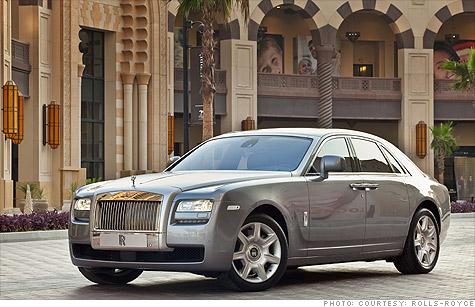
The 2011 Ghost is 17 inches shorter, 350 pounds lighter -- and $135,000 less expensive than its larger sibling, the Rolls-Royce Phantom. It is also better looking and more fun to drive, and is expected to double worldwide sales of the venerable brand.
Mind you, that is doubling off a very small base. The market for super-premium cars is tiny. Rolls sold 1,002 cars last year, 35% to 40% of them in the U.S. Toyota (TM) sells that many Camrys in a day.Driving a Camry or any other mass-produced car was never like this, however. A weekend behind the wheel of the Ghost is like relaxing in a fine hotel. You are being pampered. Surrounded by luxurious materials, your comfort is accorded the highest priority, and your instructions, whether delivered by foot or finger, are immediately and discretely carried out.
The Ghost is an investment in peace of mind for those who can afford it. With a base sticker price of $245,000, it costs more than most people make in a year.
At this point in its 106-year history, you would think that super-luxury transportation would be second nature to Rolls, but the marque has endured a number of ups and downs.
The modern Rolls-Royce Motor Cars was created in 1998, when Germany's BMW bought the rights to the brand, erected a plant in Goodwood, England and began designing an all-new car line. The original Phantom sedan, introduced in 2003, seemed a strange way to start.
The Phantom is a brute: massive, imposing, and awkward. Designed as a car to be driven in, not driven, it became a symbol of ostentation in an age where showy displays of wealth are discouraged, if not actually hazardous to safety and well-being. Two subsequent model variants, a coupe and a drophead ("convertible" in American-ese) did little to mute its impact.
Rolls discovered that the Phantom was so imposing that owners were keeping it in their garages, taking it out only for special occasions. Sales took several years to reach BMW's target of 1,000, hitting 1,212 in 2008. Rolls seemed more of a sideline than an actual business.
Cue the Ghost. Besides being smaller, lighter, and less expensive, it is better proportioned, more refined and more aesthetically pleasing.
While the Phantom had a comically long hood ("bonnet" in British-ese) and a thick C-pillar designed to shield the rear-seat occupants from public view, the Ghost is balanced front and back. The rectangular headlights and newly-recessed radiator grille look as if they were made for each other rather than being the product of a shotgun wedding. Shapes and curves blend into the overall body rather than clashing abruptly with each other.
Inside, the new car delivers an even more dramatic upgrade. The instruments, gauges and screens are pleasingly arranged rather than crammed together. Many functions can be accessed by simply pushing a button rather than paging through an endless number of screens, and data is conveyed in a particularly elegant font.
Nor has Rolls forgotten what makes British luxury cars so endearing. It remembered to include such pleasing, if anachronistic, touches as round vents, organ-stop controls and the obligatory leather, wool, and wood trims.
Underway, the Ghost is nothing less than a revelation. This is the quietest and most comfortable car I have driven.
The Ghost is powered by a V-12 engine (compliments of BMW, which contributed 20% of the auto's components) with twin turbochargers that produce 576 horsepower. That's sufficient muscle to fling the Ghost to 60 miles per hour in 4.7 seconds, yet thrifty enough to win an EPA mileage rating of 13 mpg city/20 mpg highway. That compares with 11mpg/18mpg for the Phantom. Even plutocrats like to feel as if they are doing something good for to the environment.
I did find the steering wheel, traditionally skinny, unnaturally thin for a car of this heft. But I never worried about where I was heading -- or how long it took to get there. Like the Phantom, the Ghost has a power reserve dial in place of the tachometer that indicates how much of the engine's oomph is available to driver. It seldom dropped below 80% during my stewardship.
I could go on about the umbrella holders in the front doors, the rear-hinged rear doors, the switch-operated electric door-closers and the Spirit of Ecstasy hood ornament that disappears with the touch of a button. These are features that are unique, quaint and endearing.
But the real message here is that Rolls is now in a position to waft well into its second century with a sedan whose owners should actually enjoy driving for themselves. ![]()



















